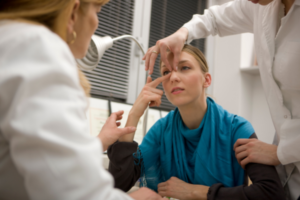When it comes to any surgery, safety is the primary concern. While rhinoplasty is a common operation, it has certain contraindications, risks, and side effects. Fortunately, the majority of adverse consequences can be prevented by:
- Choosing the right surgeon.
- Following the doctor’s advice to the letter.
- Preparing for the surgery
If you are weighing the pros and cons of a nose job, it’s imperative to consider safety. The more time you spend gathering information, the better you can prepare for the surgery and minimize safety issues.
Let’s take a closer look at how safe rhinoplasty surgery really is.
A Major Surgical Procedure
Since a nose is a small body part, many people mistakenly believe that rhinoplasty is a minor surgery. In reality, since your nose is an integral part of the respiratory system, a nose job is a major surgical procedure. Mistakes made during the surgery could affect the way a person breathes, hindering the quality of life substantially.
Important: If you had a bad nose job experience, you can rectify the situation with revision rhinoplasty.
Improving your nose’s functions and aesthetic appearance requires expert knowledge of complicated rhinoplasty techniques and the respiratory system’s operation.
Only a highly professional surgeon with sufficient experience can maximize the safety of the procedure while ensuring the best outcome.
Promises and Guarantees
One of the biggest issues with rhinoplasty is the inability of the surgeon to predict the difficulty of the procedure before it actually starts. Understanding the degree of technical difficulty and the probable outcome of the surgery requires in-depth expertise. The surgeon needs to consider a variety of factors including:
- Skin thickness
- Bone, cartilage, and muscle structure
- Blood supply particularities
- Deformities and humps
A recent study suggests that about 85% of patients are satisfied with rhinoplasty results. However, without a complex analysis, it’s impossible to guarantee the success of the procedure.
Just like with any cosmetic surgery, you can’t expect the surgeon to provide guarantees. However, by choosing the most experienced candidate and a well-equipped facility, you can expect the best possible results.
Contraindications
Unfortunately, not all people are eligible for a rhinoplasty. While an experienced surgeon can achieve excellent results with the toughest cases, some contraindications still exist.
They include:
- Obstructive sleep apnea — patients who have this condition are at high risk for post-surgery complications.
- Cocaine abuse — patients who inhale drugs (especially cocaine) suffer from extreme vasoconstriction and mucosal inflammation, making the operation difficult. They are also more prone to post-surgery complications.
- Blood disorders — patients with coagulation problems need special attention during the procedure. Serious blood-related issues could make it impossible to perform major surgery.
- Unstable mental condition — patients with psychiatric problems, personality disorders, and BDD (Body Dysmorphic Disorder) may not be eligible for a nose job unless it’s necessary to restore the breathing function.
- Previous rhinoplasties — patients who already had a rhinoplasty within 12 months should wait until it’s safe to repeat the procedure. Numerous rhinoplasty procedures could result in atrophic skin–soft tissue envelope and significant scarring.
- Unrealistic expectations — while wrong expectations don’t affect the safety of the surgery, they could impact the recovery process, making the procedure dangerous for the patient.
- Serious cardiovascular problems — general anesthesia can be taxing on patients with severe heart problems. Some people may even have a heart attack during the procedure.
- Severe diabetes — severe diabetes affects the body’s healing functions, making the recovery complicated. Meanwhile, any surgery affects blood sugar levels.
- Pregnancy — any surgery and anesthesia during pregnancy can put both the mother and the baby at risk.
- Smoking — tobacco smoking interferes with the patient’s respiratory function and may negatively affect the anesthesia. Quitting smoking several weeks before the procedure can minimize the related risks.
Ignoring contraindications could lead to serious safety concerns. However, even if you have any of the above issues, it doesn’t mean that rhinoplasty is out of your reach. Each case must be discussed individually.
If you want to get a nose job and have contraindications, make sure to consult a surgeon before giving up.
Risks and Side Effects
While the majority of rhinoplasty procedures don’t result in any complications, some risks still exist.
Risks
- Bruising and swelling
- Bleeding
- Infection
- Airway problems
- Perforation of the septum
- Scarring
- Psychological problems (if unhappy with the results)
Side Effects:
- Difficulty breathing
- Poor wound healing
- Infection
- Skin discoloration
- Change in skin sensation
- Temporary loss of smell
- Temporary painful sensations
General Anesthesia Risks and Side Effects
Besides other surgery-related risks, you need to consider side effects related to general anesthesia.
- Dizziness
- Difficulty urinating
- Bruising from the IV drip
- Nausea
- Sore throat
- Allergic reactions
The majority of the above side effects can be minimized and eliminated by choosing the right facility and an experienced anesthesiologist. However, you should be careful if you have:
- Obstructive sleep apnea
- Seizures
- Serious heart, lung, and kidney conditions
- High blood pressure
- Alcoholism and smoking habits
- Drug allergies
- Diabetes
- Obesity
In many cases, you can minimize risks and side effects simply by:
- Being straightforward about your medical history
- Following your doctor’s instructions closely
- Staying informed about the procedure
- Adjusting your lifestyle
- Changing your diet
- Kicking bad habits
It’s especially important to contact your doctor immediately in case you feel that something is going wrong after the surgery. A timely reaction could minimize negative consequences.
The Takeaway: Is Rhinoplasty Safe?
More than 200,000 rhinoplasty surgeries are performed in the United States every year. The risks and side effects associated with the procedure are minor.
With the right approach to choosing the surgeon, picking the facility, and making preparations, it’s possible to maximize the safety of the operation.
Since rhinoplasty is major surgery, it’s impossible to guarantee 100% safety. Thankfully, the percentage of complications is minor.
Would you like to learn more about rhinoplasty and address safety concerns? Contact us at any convenient time. Dr. Hershcovitch, MD, and his team have performed numerous rhinoplasty procedures. They focus on safety, patient experience, and outstanding results.


